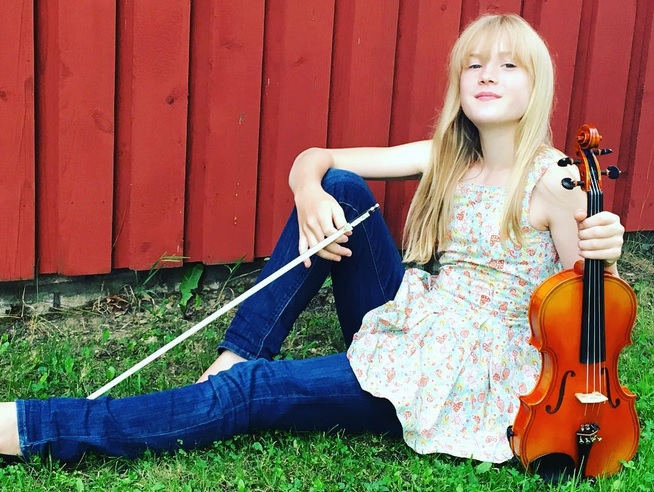Welcome to the world of Estella Elisheva

Practicing violin: Playing Odessa Bulgar (Klezmer traditional)
A post shared by Estella Elisheva (@estella.elisheva) on
Klezmer (Yiddish: כליזמר or קלעזמער (klezmer), pl.: כליזמרים (klezmorim) – instruments of music) is a musical tradition of the Ashkenazi Jews of Eastern Europe. Played by professional musicians called klezmorim in ensembles known as kapelye, the genre originally consisted largely of dance tunes and instrumental display pieces for weddings and other celebrations. In the United States the genre evolved considerably as Yiddish-speaking Jewish immigrants from Eastern Europe, who arrived between 1880 and 1924, came into contact with American jazz. During the initial years after the klezmer revival of the 1970s, the American sub-variety was what most people knew as klezmer, although in the 21st century musicians began paying more attention to the “original” pre-jazz traditions as revivalists including Josh Horowitz, Yale Strom and Bob Cohen have spent years doing field research in Eastern/Central Europe. Additionally, later immigrants from the Soviet Union, such as German Goldenshtayn, took their surviving repertoires to the United States and Israel in the 1980s.
Compared with most other European folk-music styles, little is known about the history of klezmer music, and much of what is said about it remains uncertain.
Etymology
The term klezmer comes from a combination of Hebrew words: kli, meaning “tool, or utensil” and zemer, meaning “to make music”; leading to k’li zemer כְּלִי זֶמֶר, literally “vessels of song” = “musical instrument”.
Originally, klezmer referred to musical instruments, and was later extended to refer, as a pejorative, to musicians themselves. From the 16th to 18th centuries, it replaced older terms such as leyts (clown). It was not until the late 20th century that the word came to identify a musical genre. Early 20th century recordings and writings most often refer to the style as “Yiddish” music, although it is also sometimes called Freilech music (Yiddish, literally “Happy music”). The first recordings to use the term “klezmer” to refer to the music were The Klezmorim’s East Side Wedding and Streets of Gold in 1977/78, followed by Andy Statman and Zev Feldman’s Jewish Klezmer Music in 1979.
Style
Klezmer is easily identifiable by its characteristic expressive melodies, reminiscent of the human voice, complete with laughing and weeping. This is not a coincidence; the style is meant to imitate khazone and paraliturgical singing. A number of dreydlekh (a Yiddish word for musical ornaments), such as krekhts (“sobs”) are used to produce this style.
Various musical styles influenced traditional klezmer music. Perhaps the strongest and most enduring is Romanian music. Klezmer musicians heard and adapted traditional Romanian music, which is reflected in the dance forms found throughout surviving klezmer music repertoire (e.g., Horas, Doinas, Sirbas, and Bulgars)
Repertoire
According to Walter Zev Feldman, the klezmer dance repertoire seems to have been relatively uniform across the areas of Jewish settlement in the Russian Empire. Much of the traditional klezmer repertoire was created by professional klezmer musicians in the style of their region or tradition, and much co-territorial music such as non-Jewish folksongs, especially Romanian music (mainly from Moldavia), as well as Ukrainian music and Ottoman music, and the musics of other minorities living in the same areas as Jews in Southeastern Europe such as Crimean Tatars.
Historically, young klezmorim learned tunes from their family and their elders in bands. However, there were several times in history where this transmission broke down, including mass emigration, but especially the Holocaust, which destroyed most of Jewish life and culture in Europe. Few scions of klezmer dynasties remained in Europe, one notable exception being Leopold Kozlowski of Poland.
Undoubtedly, much has been lost of the repertoires played in various locations and social contexts—especially wedding repertoire, since although Jewish weddings could last several days, early recording technology could only capture a few minutes at a time. Also, recordings specific to one area may not have represented klezmer repertoire from other parts of the region. Fortunately, a few older klezmorim—such as Leon Schwartz, Dave Tarras, and German Goldenshtayn—survived into the klezmer revival era and could recall some forgotten repertoire. Also, some transcriptions survive from the 19th century. Some ethnomusicological work from Jewish Eastern Europe is still available in print, notably the work of Soviet Jewish field researcher Moshe Beregovski.
In the 21st century, klezmer is typically learned from “fake books” and transcriptions of old recordings, although the music was traditionally transmitted and learned by ear.
